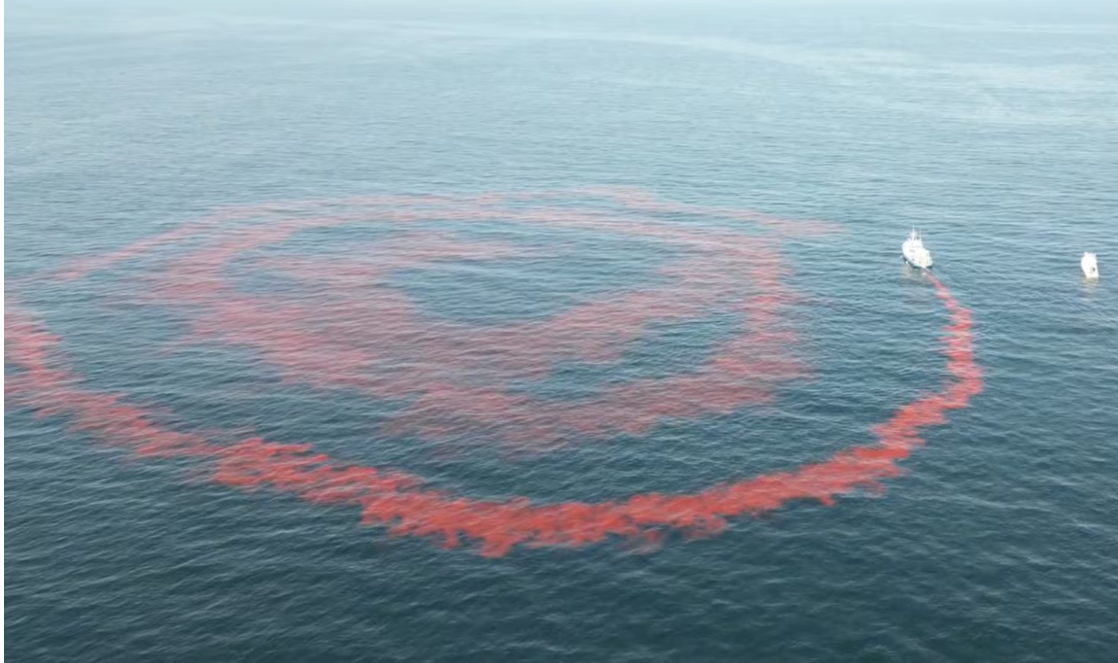美国环保署正在考虑在玛莎葡萄园岛南部进行一项有争议的地球工程海洋实验

【中美创新时报2024 年 7 月 21 日编译讯】(记者温友平编译)科学家们正在寻求许可推进一项实验,该实验需要将氢氧化钠溶液释放到公海中。《波士顿环球报》记者艾琳·道格拉斯(Erin Douglas)对此作了下述报道。
海洋每年吞噬大量二氧化碳污染物,有助于缓解气候变化,但代价是海洋变得越来越酸。但是,如果我们可以通过给大西洋提供相当于巨型抗酸药片的东西来增加它对温室气体的需求呢?
这是备受尊敬的伍兹霍尔海洋研究所(一家私人海洋研究非营利组织)的科学家计划进行的一项有争议的地球工程实验的基本假设。
科学家们正在等待联邦政府批准,将 6,600 加仑的氢氧化钠溶液和淡水混合物排放到玛莎葡萄园西南 10 英里的公海,这是一项史无前例的试验,定于 9 月进行。如果这次试验进展顺利,那么明年夏天,科学家们将进行一项更大规模的实验,将第一次试验的 10 倍——66,000 加仑——排放到威尔金森盆地,这是缅因湾的一个深水区,位于格洛斯特以东约 50 英里处。
该项目的科学家表示,这些实验将是证明一个特别新颖的想法的重要一步,即通过提高海洋的 pH 值,从而让海洋吸收更多的二氧化碳,从大气中去除导致气候变暖的二氧化碳。

批评该项目的海洋生物学家表示,氢氧化钠(商业产品中称为苛性钠或碱液)是一种剧毒化学物质,高浓度时会灼伤皮肤,当混合物释放时,几乎肯定会杀死或伤害水面上的任何海洋生物。
大约一小时后,玛莎葡萄园岛南部的羽流最初将覆盖约 56 英亩,面积略大于波士顿公园。伍兹霍尔的科学家承认对海洋生物的影响,但表示羽流只会在一分钟左右的时间内具有剧毒,他们会监测任何影响。船上还会有一名海洋哺乳动物观察员,只有在该地区没有哺乳动物的情况下才会进行释放。
“我们不希望鲸鱼或其他生物接触到它,”氢氧化钠实验的联合首席研究员、伍兹霍尔海洋研究所地质和地球物理系名誉科学家丹尼尔·麦考克尔说。
5 月底,美国环境保护署初步批准了这两项实验,预计将于今年夏天做出最终决定;如果获得批准,这将是该机构首次批准“海洋碱度增强”项目。
随着地球接近关键变暖阈值,科学家们正在认真探索许多不太可能实现的地球工程理念,这些实验是其中之一。如果超过这个阈值,可能会带来更严重的洪水、热浪、生物多样性丧失等。地球工程旨在通过故意改变气候来消除大气中的温室气体。这些想法包括使云层变亮、向大气中喷洒气溶胶以遮挡阳光,以及化学改变海洋。
“这些实验绝对是这个扩大规模过程的下一步,”麦考克尔说。“但与任何潜在的大规模应用相比,它们仍然规模很小,而且受到限制。”
目前,海洋每年吸收大气中大约四分之一的人为二氧化碳排放量。当碱性极强的海水与表面空气相互作用时,它会慢慢吸收二氧化碳,从而使水变得更酸。
“LOC-NESS”实验(将海洋碳锁定在东北大陆架和斜坡的缩写)需要用船释放氢氧化钠溶液。这会导致海水的 pH 值飙升至非常有毒的水平,但羽流在与海水混合时会迅速稀释。
“化学反应的直接变化是二氧化碳吸收的原因,”McCorkle 说。
该溶液将与红色染料一起释放,以便科学家追踪羽流。几天之内,海水的 pH 值预计将恢复到正常范围,尽管比平时更碱性,并继续吸收二氧化碳。而二氧化碳将通过化学反应转化为碳酸氢盐,这种物质通常可以稳定数千年。
根据 WHOI 的申请,在第一次实验中最多可以封存 20 吨二氧化碳(与每年排放的数百亿吨相比,这只是一个很小的数量)。
但环保组织担心这项实验对生态系统构成了太多未知威胁。
“我们不知道确切的风险是什么,因为以前没有人疯狂到这样做,”马萨诸塞州地球之友高级活动经理 Ben Day 说。“这有点像最初让我们来到这里的想法:认为我们可以控制地球系统而不会产生意想不到的后果。”
地球工程实验经常引起环保组织的强烈反对,他们认为,在全球范围内对自然化学、生物或大气过程进行调整应该作为应对气候变化的最后手段。
“坦率地说,在我们实际上还能解决气候危机的时候,还不是做这件事的时候,”生物多样性中心政府事务主任布雷特·哈特尔说。地球工程“消除了解决问题根本原因的紧迫性。”
哈特尔和其他倡导者对这项实验是否有效表示怀疑:目前还不清楚科学家是否能够核实海洋中封存了多少二氧化碳。(测量海洋中封存的碳极其困难;项目科学家表示,他们将能够测量水化学变化以证明有效性,至少在最初是这样。)
科学家和其他从事地球工程研究的人表示,它代表了了解风险所必需的研究类型,他们已经从实验室中学到了很多东西。
“在某个时候,你必须走出去,处理现实海洋中的复杂问题,”麦考克尔说。
然而,一些科学家警告说,这对海洋生物是危险的。澳大利亚詹姆斯库克大学的兼职海洋科学家詹姆斯·克里说,即使是相对少量的氢氧化钠溶液被释放到海洋中,也会导致“基础”海洋生物死亡,包括浮游植物、浮游动物和鱼幼体,并因碱度大幅上升而导致其他生物流离失所或受伤。
“我认为这本质上是在试图用另一种污染物来解决一种海洋污染——二氧化碳,”克里说,他也是总部位于瑞士的海洋保护非营利组织 OceanCare 的高级海洋和气候科学家。
美国环保署发言人安吉拉·哈克尔在一份声明中写道,作为许可程序的一部分,该机构正在与国家海洋渔业局和美国鱼类和野生动物管理局就对鱼类栖息地和濒危物种的潜在影响进行磋商。
近年来,地球工程研究吸引了大量风险投资,反对派经常批评其炒作过度。但领导该项目的 Cape 科学家指出,这项实验并非由一家以盈利为目的的初创公司进行,而是由一家研究机构进行,他们提出了一个合理的科学问题:这能行得通吗?
即使能行得通,地球工程研究人员和批评者都一致认为,仅靠二氧化碳去除技术不足以应对气候变化。虽然它可能在边际上有所帮助,但大多数人认为它不能取代减少温室气体污染所需的大规模减排。
“我们现在不应该大规模地进行 [地球工程],而应该试图改变我们的能源系统,”圣地亚哥大学研究过这一主题的海洋化学家 Andrew Dickson 说。“但是……你现在必须做大量的背景科学研究,才有机会在你说现在是开始的好时机的时候。”
题图:伍兹霍尔海洋研究所于 2023 年 8 月在科德角南部释放了一种无毒荧光染料。JACK GENTEMPO/BRICK CITY TV
附原英文报道:
EPA weighing controversial geoengineering ocean experiment south of Martha’s Vineyard
Scientists are seeking permission to advance an experiment that entails releasing a sodium hydroxide solution into the open ocean.
By Erin Douglas Globe Staff,Updated July 21, 2024
Oceans swallow huge amounts of carbon dioxide pollution each year, helping to mitigate climate change, but at the cost of the seas becoming more and more acidic. But what if we could increase the Atlantic’s appetite for the greenhouse gas by giving it the equivalent of a giant antacid tablet?
That is the basic hypothesis behind a controversial geoengineering experiment planned by scientists at the highly respected Woods Hole Oceanographic Institution, a private marine research non-profit organization.
The scientists are awaiting federal approval to release a 6,600-gallon mixture of sodium hydroxide solution and freshwater into the open ocean 10 miles southwest of Martha’s Vineyard in a first-of-its-kind trial scheduled for September. If that test goes well, then next summer, scientists would conduct an even larger experiment 10 times the first amount — 66,000 gallons — into the Wilkinson Basin, a deepwater section of the Gulf of Maine about 50 miles east of Gloucester.
The projects’ scientists say the experiments will be a significant step toward proving a particularly novel idea to remove climate-warming carbon dioxide from the atmosphere by increasing the pH of the ocean, and thus allowing it to absorb even more carbon dioxide.
Sodium hydroxide, known in commercial products as caustic soda or lye, is highly toxic chemical that can burn skin at high concentrations, and will almost certainly kill or injure any marine life at the water’s surface when the mixture is released, marine biologists who criticized the project said.
The plume south of Martha’s Vineyard would initially span about 56 acres after about one hour, a surface area somewhat larger than that of Boston Common. The Woods Hole scientists acknowledge the impacts to marine life but say the plume will be highly toxic for only a minute or so, and that they’ll monitor any impacts. There will also be a marine mammal observer on board and the release will only proceed if there are no mammals in the area.
“We don’t want there to be a prospect of a whale or something coming into contact with that,” said Daniel McCorkle, a co-principal investigator for the sodium hydroxide experiment and emeritus scientist in WHOI’s department of geology and geophysics.
In late May, the Environmental Protection Agency gave tentative approval for both experiments and is expected to make a final determination this summer; if granted, it would mark the agency’s first permit for an “ocean alkalinity enhancement” project.
The experiments are among the many long-shot geoengineering ideas scientists are exploring in earnest as the planet approaches critical warming thresholds that, if exceeded, will likely bring worsened floods, heat waves, biodiversity loss, and more. Geoengineering aims to remove greenhouse gases from the atmosphere by deliberately changing the climate. The ideas range from brightening clouds, to spewing aerosols into the atmosphere to block the sun, to chemically altering the ocean.
“These experiments are absolutely sort of a next step in this scaling up process,” McCorkle said. “But they are still quite small and constrained, compared with any potential future application at scale.”
Oceans currently absorb about one quarter of human-made carbon dioxide emissions from the atmosphere every year. When seawater, which is very basic, interacts with air at the surface, it slowly absorbs carbon dioxide, which makes the water more acidic.
The “LOC-NESS” experiment (an acronym for Locking Away Ocean Carbon in the Northeast Shelf and Slope) would entail releasing a sodium hydroxide solution by boat. That would cause the pH level of the seawater to shoot up to very toxic levels, but the plume would dilute rapidly as it mixes with seawater.
“The immediate change in the chemistry is what drives the carbon dioxide uptake,” McCorkle said.
The solution would be released with a red dye to allow scientists to track the plume. Within a few days, the seawater’s pH is expected to return to normal ranges, though more alkaline than usual, and continue taking up carbon dioxide. And the carbon dioxide will transform, locked away by chemical reactions as bicarbonate, which are typically stable for thousands of years.
Up to 20 tons of carbon dioxide could be sequestered in the first experiment (a tiny amount compared to the tens of billions of tons emitted each year), according to the WHOI’s application.
But environmental groups are concerned the experiment poses far too many unknown threats to the ecosystem.
“We don’t know exactly what the risks are, because no one has been crazy enough to do this before,” said Ben Day, a Massachusetts-based senior campaign manager for Friends of the Earth. “It’s kind of like the thinking that got us here in the first place: Thinking that we can control Earth’s systems without unintended consequences.”
Geoengineering experiments frequently provoke strong opposition from environmental groups that argue that tinkering with natural chemical, biological, or atmospheric processes on a global scale ought to be treated as a last resort in tackling climate change.
“The time to do this is, frankly, not when we still actually can solve the climate crisis,” said Brett Hartl, government affairs director for the Center for Biological Diversity. Geoengineering “takes away urgency from dealing with the underlying root causes of the problem.”
Hartl and other advocates are skeptical the experiment will work: It’s unclear if scientists will be able to verify how much carbon dioxide is sequestered in the sea. (It’s exceedingly difficult to measure carbon sequestered in the ocean; project scientists say they’ll be able to measure changes in water chemistry to prove efficacy, at least initially.)
The scientists, along with others working on geoengineering, say it represents exactly the type of research necessary to understand the risks, and that they’ve learned what they can from the lab.
“At some point you have to go out and deal with the complexities in the real ocean,” McCorkle said.
Some scientists caution, however, there are dangers to marine life. Even a relatively small amount of sodium hydroxide solution released in the ocean will result in killing “foundational” marine life, including phytoplankton, zooplankton, and fish larvae, and displacing or injuring other creatures due to the huge spikes in alkalinity, said James Kerry, an adjunct marine scientist at the James Cook University in Australia.
“I see it, essentially, as trying to address one form of marine pollution — carbon dioxide — with another” pollutant, said Kerry, who is also a senior marine and climate scientist for OceanCare, a marine conservation nonprofit organization based in Switzerland.
In a statement, EPA spokesperson Angela Hackel wrote the agency is consulting with the National Marine Fisheries Service and US Fish and Wildlife about potential impacts to fish habitats and endangered species as part of the permitting process.
Geoengineering research has attracted enthusiastic venture financing in recent years, and is oft criticized by opposing groups as overly hyped. But the Cape scientists leading the project point out the experiment is not being pursued by a start-up company with profit in mind, but by a research institution with a legitimate scientific question: Could this work?
Even if it does, both geoengineering researchers and critics agree that carbon dioxide removal technologies are alone not enough to combat climate change. While it may help on the margins, most agree it cannot be a replacement for the massive cuts needed to reduce greenhouse gas pollution.
“We should not be doing [geoengineering] at a large scale now, instead of trying to change our energy system,” said Andrew Dickson, a marine chemist at the University of San Diego who has researched the subject. “But … you’ve got to do a lot of this background science now to even have a chance of being there when you would say that it would be a good time to start.”

